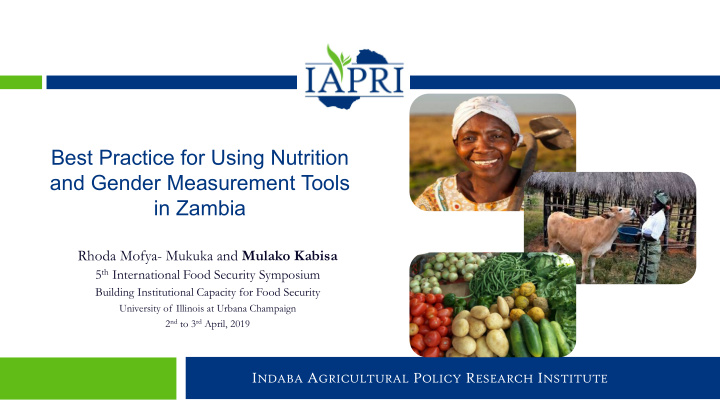



Best Practice for Using Nutrition and Gender Measurement Tools in Zambia Rhoda Mofya- Mukuka and Mulako Kabisa 5 th International Food Security Symposium Building Institutional Capacity for Food Security University of Illinois at Urbana Champaign 2 nd to 3 rd April, 2019 I NDABA A GRICULTURAL P OLICY R ESEARCH I NSTITUTE Indaba Agricultural Policy Research Institute
ZAMBIA’S STATUS QUO 2 The labour burden of rural women is high, yet their time use is 59.3% of unpaid not adequately family workers are documented women Women are often involved in food crop production and men in cash crop production Indaba Agricultural Policy Research Institute
FIELD TESTED TOOLS 3 • Household Dietary Diversity Score (HDDS) • Minimum Dietary Diversity for Women (MDD-W) Household Food Access • Minimum Dietary Diversity for Children (MDD-C) • Household Hunger Scale (HHS) • Women’s Empowerment in Agriculture Index (WEAI) and Women’s Assets Ownership Index (WAOI) • Asset Ownership Women’s Empowerment • Access to credit • Agricultural production • Decision making (input and extent) • Time allocation • Leisure time Indaba Agricultural Policy Research Institute
EMPOWERING WOMEN THROUGH AGRICULTURAL SUPPORT (EWAS) PROJECT 4 Improve female farmers’ livelihoods through increased incomes and resilience to the effects of climate change. Climate Incomes and Smart Livelihoods Gender and agriculture by Scaling Nutrition and Food Home Security Gardens Indaba Agricultural Policy Research Institute
METHOD 5 Questionnaire Questionnaire Self administered administered to the administered by the questionnaire by respondent by the enumerators to 148 enumerators supervisors after the women main interview Indaba Agricultural Policy Research Institute
RESULTS: FOOD ACCESS 6 “The respondent found it difficult to remember the hunger events as 14 isolated because of regularly having 12 insufficient food in the household.” 10 “Her understanding of hunger was Percentage having only vegetables with nshima 8 so she found it difficult to reconcile 6 hunger as having no food completely.” 4 “The question is difficult to answer 2 because you anticipate being given 0 food when asked such a question so HDDS MDD-W MDD-C HHS being truthful can be difficult.” Measurement Tool Enumerators Respondents Indaba Agricultural Policy Research Institute
RESULTS: WOMEN’S EMPOWERMENT 7 30 “Cultural norms mean that women would think they will be looked at as 25 disrespectful to their husbands if they 20 Percentage said they took a bigger part in decision making.” 15 “I was not comfortable with the way the 10 question was coming out. Wife and 5 husband make decisions together which makes it difficult to answer the question.” 0 “It makes someone wonder why someone would want to know your household dynamics. What are their intentions?’” Gender Equity Indicators Enumerators Respondents Indaba Agricultural Policy Research Institute
BEST PRACTICE 8 FOOD ACCESS Avoid data collection on different dietary diversity indicators in one questionnaire if possible When conducting HHS during the lean season, caution must be taken because respondents may report higher than actual levels of hunger in anticipation of food aid Differentiate the terms ‘hunger’ and ‘insufficient food’ clearly to the respondent WOMEN’S EMPOWERMENT Explain the difference between input and extent Consider the cultural norms that govern the attitudes towards women giving input and the extent of their input in decision making Be open about why data is being collected and emphasize anonymity Indaba Agricultural Policy Research Institute
9 THANK YOU Indaba Agricultural Policy Research Institute
Recommend
More recommend